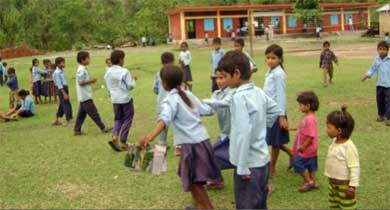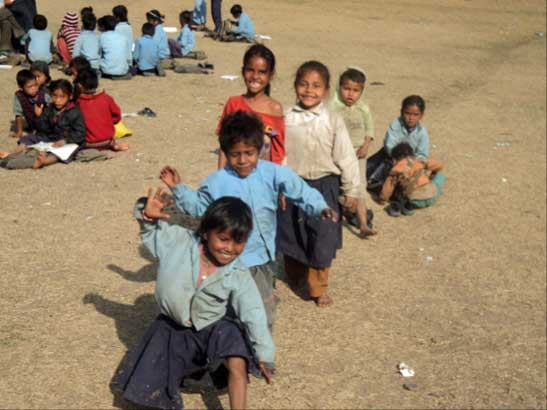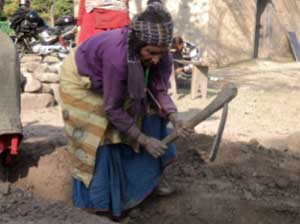The Samaiji Primary School in Jagati, Nepal was completed on May 12, 2011!

Jagati was chosen as a project site after members of the community visited another village with a buildOn school. They were impressed by the activities they saw in this village, and contacted the buildOn office to seek a school of their own. After several community meetings with buildOn staff, it was clear that the people of Jagati trusted buildOn - and clear to the Nepal staff that this was a community dedicated to improving education for its children.
This school project broke ground on January 27th, 2011 and was completed on May 12th, 2011. It finished 11 days behind schedule due to heavy rains and also a short strike in the Kailali district that interrupted transportation for a few days.
The completed school in Jagati has 3 classrooms with a poured concrete floor and a concrete slab roof, as well as 2 latrines. The buildings are made of fired clay bricks and reinforced with rebar columns. Each classroom has been furnished with desks and permanent chalkboards. The Jagati students began attending classes in their new school block in June of 2011.
This school project broke ground on January 27th, 2011 and was completed on May 12th, 2011. It finished 11 days behind schedule due to heavy rains and also a short strike in the Kailali district that interrupted transportation for a few days.
The completed school in Jagati has 3 classrooms with a poured concrete floor and a concrete slab roof, as well as 2 latrines. The buildings are made of fired clay bricks and reinforced with rebar columns. Each classroom has been furnished with desks and permanent chalkboards. The Jagati students began attending classes in their new school block in June of 2011.
Community Member Comments


"Education is important because it makes people in society aware. A man with awareness can develop his village.”
- Mr. Dhundi Raj Kandel, age 64, school committee chairperson
“I hope in the future this school will be a model secondary school.”
- Mr. Buddi Singh Sapkota, age 27, school principal
“This school will change our communal feeling. People will work together more now for community development. They have gained a new concept of unity and working style in the community.”
- Mrs. Nanda Ojha, age 26, teacher
“I learned how to do social work in the village. We can complete any community development work easily when we do it together. We completed the strong new school building doing hard work together. buildOn supports us in this regard.”
- Mr. Prem Acharya, age 40, parent
“We are very happy having a new strong school building. I would like to give thanks so much to the US team who supported our school. I will never forget the support of the American people. Namaste and dhanyabad for the help in our remote village!”
- Mr. Mahesh Acharya, age 12, grade 5 student
- Mr. Dhundi Raj Kandel, age 64, school committee chairperson
“I hope in the future this school will be a model secondary school.”
- Mr. Buddi Singh Sapkota, age 27, school principal
“This school will change our communal feeling. People will work together more now for community development. They have gained a new concept of unity and working style in the community.”
- Mrs. Nanda Ojha, age 26, teacher
“I learned how to do social work in the village. We can complete any community development work easily when we do it together. We completed the strong new school building doing hard work together. buildOn supports us in this regard.”
- Mr. Prem Acharya, age 40, parent
“We are very happy having a new strong school building. I would like to give thanks so much to the US team who supported our school. I will never forget the support of the American people. Namaste and dhanyabad for the help in our remote village!”
- Mr. Mahesh Acharya, age 12, grade 5 student
Jagati Community Profile
Jagati was founded in 1975 by Mr. Ganga Ram Roka. Today there are 450 people in Jagati living in 51 households. Most of them migrated from higher altitudes to the low hills of Jagati. The majority are Hindu, though there are also a few Christian people in the community.
The primary activities in Jagati are farming and livestock breeding; the people grow rice, wheat, oilseed and corn. The climate in Jagati is mild all year round, neither extremely hot nor extremely cold. Jungle surrounds the village and there is also a nearby river. During monsoon season there is danger of floods and landslides. The closest medical clinic is 15km from Jagati in Attariya, so sick people are usually carried by stretcher to the road where they can find a vehicle to complete the journey.
Nepal’s population comprises a huge variety of ethnic groups, tribes and castes, several of which are represented in Jagati, including the Chhetri (the majority ethnic group in Nepal), the Magar (one of the oldest know tribes in Nepal), the Brahmin (the highest caste in Nepal’s system) and the Dalits (outcasts known as untouchables).
The primary activities in Jagati are farming and livestock breeding; the people grow rice, wheat, oilseed and corn. The climate in Jagati is mild all year round, neither extremely hot nor extremely cold. Jungle surrounds the village and there is also a nearby river. During monsoon season there is danger of floods and landslides. The closest medical clinic is 15km from Jagati in Attariya, so sick people are usually carried by stretcher to the road where they can find a vehicle to complete the journey.
Nepal’s population comprises a huge variety of ethnic groups, tribes and castes, several of which are represented in Jagati, including the Chhetri (the majority ethnic group in Nepal), the Magar (one of the oldest know tribes in Nepal), the Brahmin (the highest caste in Nepal’s system) and the Dalits (outcasts known as untouchables).
Prior School Conditions

Children Playing with an outdoor class in the background
Samaiji Primary School - This school was formally established 12 years ago but until the new school was built there were no permanent classrooms in Jagati. There are currently 171 students enrolled in Samaiji Primary school - 86 boys and 85 girls. Some of these children used to study in classrooms made of rocks and mud, and others attend classes outdoors with no shelter at all. There are five teachers (see photo on right) working in Jagati teaching grades 1-5. Three of these teachers are from Jagati, and the other two come from the nearby village of Majagau. Students who complete their primary education must walk about 3km to the nearest secondary school to continue their education.

The Construction Process

Volunteers at work after the groundbreaking

Women digging the foundation

Still Digging
The project broke ground on Thursday, January 27th. This was the first buildOn school groundbreaking in Nepal in 2011, and the entire project will took approximately 12 weeks to complete.
The people of Jagati contributed a total of 1,626 volunteer workdays to the project. Before starting construction they also collected local materials for the project and met with buildOn staff to sign the covenant which spelled out the following responsibilities:
Community Contribution
• Unskilled labor: 20 workers (10 women and 10 men) per day, six days per week
• Commitment to educating boys and girls equally
• The land on which the school will be built
• High quality local materials: sand, gravel, water & rocks
• Volunteer management committee made up of 12 villagers (six women, six men)
• Lodging for buildOn Field Coordinator and skilled laborers in local homes
• Basic construction tools (shovels, picks, buckets, etc.) when available
buildOn and Opportunity for All Contribution
• Engineering and architecture
• Construction materials (excluding local materials) for school and latrine
• Skilled labor and plans needed to build the school
• Project management (buildOn coordinators)
• Instruction in basic construction techniques
• School furniture
The people of Jagati contributed a total of 1,626 volunteer workdays to the project. Before starting construction they also collected local materials for the project and met with buildOn staff to sign the covenant which spelled out the following responsibilities:
Community Contribution
• Unskilled labor: 20 workers (10 women and 10 men) per day, six days per week
• Commitment to educating boys and girls equally
• The land on which the school will be built
• High quality local materials: sand, gravel, water & rocks
• Volunteer management committee made up of 12 villagers (six women, six men)
• Lodging for buildOn Field Coordinator and skilled laborers in local homes
• Basic construction tools (shovels, picks, buckets, etc.) when available
buildOn and Opportunity for All Contribution
• Engineering and architecture
• Construction materials (excluding local materials) for school and latrine
• Skilled labor and plans needed to build the school
• Project management (buildOn coordinators)
• Instruction in basic construction techniques
• School furniture
